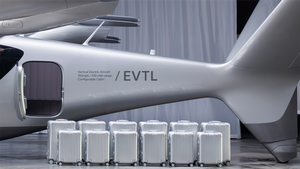- Study Did Not Meet Primary Endpoint of Clinical Symptom Reduction or Secondary Antiviral Endpoints
- Statistically Significant Percent of Subjects Who Received EDP-938 Achieved Undetectable RSV RNA at End of Treatment
- EDP-938 was Safe and Well-Tolerated
- EDP-938 Continues to be Evaluated in Ongoing and Planned Clinical Studies in High-Risk Populations
Enanta Pharmaceuticals, Inc. (NASDAQ: ENTA), a clinical-stage biotechnology company dedicated to creating small molecule drugs for viral infections and liver diseases, today reported topline results for RSVP, its Phase 2b study evaluating EDP-938, a potent N-protein inhibitor, in otherwise healthy adults with community-acquired RSV. In this low-risk patient population which had mild, self-resolving upper respiratory tract infection, EDP-938 did not meet the primary endpoint of reduction in total symptom score compared to placebo, or the secondary antiviral endpoints. However, a statistically significant difference in the number of subjects achieving undetectable RSV RNA at the end of treatment at Day 5 was observed with EDP-938 compared to placebo (p=0.033). Further, EDP-938 demonstrated a favorable safety profile, consistent with that observed in approximately 500 subjects exposed to date. Enanta continues to evaluate EDP-938 in high-risk populations in ongoing and planned clinical studies, including pediatric patients, adult hematopoietic cell transplant recipients, and a high-risk adult population, all of which have the most significant unmet need.
“While RSVP did not meet the study endpoints, we are pleased to observe a statistically significant difference in the number of subjects achieving undetectable RSV RNA at the end of treatment with EDP-938, making this the only study that has demonstrated a statistically significant antiviral effect in an otherwise healthy adult population with community-acquired RSV. The effect on RSV RNA viral load is consistent with EDP-938’s mechanism of action of inhibiting viral replication,” said Jay R. Luly, President and Chief Executive Officer of Enanta Pharmaceuticals. “Although patients were treated within 48 hours of symptom onset, a key observation in this study was that the viral load and symptoms had already peaked and were declining at the time of the first dose, indicating RSV infection resolves quickly in this otherwise healthy population.”
Dr. Luly added, “We continue to believe that RSV antiviral treatment, including EDP-938, has the greatest potential to show optimal efficacy in high-risk populations, as these patients have reduced RSV immunity which manifests in a higher and longer duration of viral load and greater disease severity, allowing a bigger window to realize the full potential of EDP-938. Moving forward, our broad clinical development plan is focused on evaluating EDP-938 in populations with the greatest unmet need, namely those who are at high-risk for severe disease, and we look forward to providing further updates on our ongoing and planned clinical studies.”
EDP-938 RSVP Phase 2b Study Topline Results
RSVP was a Phase 2b, randomized, double-blind, multicenter, placebo-controlled study in ambulatory adults with or without comorbidities aged 18 to 75 years with confirmed RSV infection within 48 hours of symptom onset. Patients were randomized 1:1 to receive once-daily 800 mg EDP-938 or placebo for 5 days and followed until Day 14. The primary objective of the study was to evaluate the effect of EDP-938 on progression of RSV infection by assessment of clinical symptoms measured over the 14-day study period. The secondary objectives evaluated the antiviral efficacy, safety, and pharmacokinetics of EDP-938.
A total of 81 patients were randomized and dosed and included in the intent-to-treat (ITT) analysis. The modified ITT efficacy analysis included only the 66 patients (33 in each group) that were subsequently confirmed to be RSV positive using a central RT-PCR test. Demographics and baseline characteristics were well balanced between the two arms, except for the median RSV viral load (5.9 and 7.1 log10 copies/mL, in EDP-938 and placebo, respectively). Overall, most of the patients were female, White, non-Hispanic, young (median age approximately 50 years old) and had a normal frailty scale score, consistent with a healthy population as per the eligibility criteria of the study. Only eight patients were 65 years or older (n=3 in EDP-938, n=5 in placebo), and a total of seven patients (n=4 in EDP-938, n=3 in placebo) had stable asthma and/or chronic obstructive pulmonary disease (COPD), at entry.
The primary endpoint, total symptom score (TSS) area under the curve (AUC) from Day 1 through Day 14, was not met. The AUC for the mean total symptom score (days x score) was not statistically different between the two groups (p=0.256). Although, the secondary antiviral endpoints were not met, a trend in favor of EDP-938 was observed with regard to the percentage of subjects achieving undetectable RSV RNA, with a statistically significant difference observed at the end of treatment at Day 5 (p=0.033).
A total of 11 (~27%) patients in both the EDP-938 and placebo arms reported treatment-emergent-adverse events. Most of the adverse events (AEs) were mild and not related to study drug. There were no severe or serious AEs, and no discontinuations due to AEs. In the study, the observed safety profile was consistent with previous clinical studies. Good EDP-938 exposures were achieved and were consistent with those observed in treated subjects in previous studies.
Data from RSVP will be presented at a future medical meeting or in a peer-reviewed publication.
EDP-938 and RSV Clinical Development Program Next Steps
Recruitment is ongoing for RSVPEDs, a Phase 2 randomized, double-blind, placebo-controlled study in hospitalized and non-hospitalized pediatric RSV patients, and RSVTx, a Phase 2b, randomized, double-blind, placebo-controlled study in adult hematopoietic cell transplant recipients with acute RSV infection and symptoms of upper respiratory tract infection. The company expects these studies to continue into 2023. Further, the company plans to initiate an additional Phase 2b study in a high-risk adult population, including the elderly and/or those with asthma, COPD, or congestive heart failure, by year-end. Finally, Enanta is on track to initiate a Phase 1 study for EDP-323, a novel, oral, direct-acting antiviral selectively targeting the RSV L-protein, in the second half of 2022. EDP-323 has shown sub-nanomolar potency against RSV-A and RSV-B in vitro and is not expected to have cross resistance to other classes of inhibitors. EDP-323 could be used as a monotherapy or in combination with other RSV mechanisms, such as EDP-938, to potentially broaden the addressable patient populations or their treatment windows.
About EDP-938
EDP-938, Enanta’s lead N-protein inhibitor, is being developed for the treatment of RSV infection, and has been granted Fast Track designation by the U.S. Food and Drug Administration. EDP-938 is a nanomolar inhibitor of both RSV-A and RSV-B activity. EDP-938 is differentiated from RSV fusion inhibitors as the N-protein inhibitor targets the virus’ replication machinery and has demonstrated a high barrier to resistance in vitro. In preclinical studies, EDP-938 maintained antiviral potency across all clinical isolates tested and was active against viral variants resistant to other mechanisms. EDP-938 demonstrated a favorable safety, pharmacokinetic and drug-drug interaction profile in an extensive Phase 1 program. In a Phase 2 challenge study, EDP-938 achieved highly statistically significant (p<0.001) reductions in RSV viral load and clinical symptoms compared to placebo, and was safe and well-tolerated with infrequent AEs. EDP-938 is currently being evaluated in RSVPEDs, a Phase 2 study in pediatric RSV patients, and RSVTx, a Phase 2b study in adult hematopoietic cell transplant recipients with RSV.
About Respiratory Syncytial Virus
RSV is the most common cause of bronchiolitis (inflammation of the small airways in the lung) and pneumonia in children under one year of age in the U.S. and a significant cause of respiratory illness in older adults and immunocompromised individuals.1 According to the Centers for Disease Control and Prevention, virtually all children in the United States get an RSV infection by the time they are two years old and one to two out of every 100 children younger than six months of age with RSV infection may need to be hospitalized.2 Globally, there are an estimated 33 million cases of RSV annually in children less than five years of age, with about 3 million hospitalized and up to approximately 120,000 dying each year from complications associated with the infection.3 RSV represents a significant health threat for adults older than 65 years of age, with an estimated 177,000 hospitalizations and 14,000 deaths associated with RSV infections annually in the United States.4
About Enanta Pharmaceuticals, Inc.
Enanta is using its robust, chemistry-driven approach and drug discovery capabilities to become a leader in the discovery and development of small molecule drugs for the treatment of viral infections and liver diseases. Enanta’s research and development programs include clinical candidates currently in development for the following disease targets: respiratory syncytial virus (RSV), SARS-CoV-2 (COVID-19) and hepatitis B virus (HBV). Enanta is also conducting research in human metapneumovirus (hMPV).
Enanta’s research and development activities are funded by royalties from hepatitis C virus (HCV) products developed under its collaboration with AbbVie. Glecaprevir, a protease inhibitor discovered by Enanta, is sold by AbbVie in numerous countries as part of its leading treatment for chronic HCV infection under the tradenames MAVYRET® (U.S.) and MAVIRET® (ex-U.S.) (glecaprevir/pibrentasvir). Please visit www.enanta.com for more information.
Forward Looking Statements Disclaimer
This press release contains forward-looking statements, including statements with respect to the prospects for further development with respect to EDP-938 for RSV. Statements that are not historical facts are based on management’s current expectations, estimates, forecasts and projections about Enanta’s business and the industry in which it operates and management’s beliefs and assumptions. The statements contained in this release are not guarantees of future performance and involve certain risks, uncertainties and assumptions, which are difficult to predict. Therefore, actual outcomes and results may differ materially from what is expressed in such forward-looking statements. Important factors and risks that may affect actual results include: the development risks of early stage discovery efforts in the disease areas in Enanta’s research and development pipeline, such as RSV; the impact of development, regulatory and marketing efforts of others with respect to competitive treatments for RSV; Enanta’s limited clinical development experience; Enanta’s need to attract and retain senior management and key scientific personnel; Enanta’s need to obtain and maintain patent protection for its product candidates and avoid potential infringement of the intellectual property rights of others; and other risk factors described or referred to in “Risk Factors” in Enanta’s most recent Form 10-Q for the fiscal quarter ended March 31, 2022 and other periodic reports filed more recently with the Securities and Exchange Commission. Enanta cautions investors not to place undue reliance on the forward-looking statements contained in this release. These statements speak only as of the date of this release, and Enanta undertakes no obligation to update or revise these statements, except as may be required by law.
1. Centers for Disease Control & Prevention – Respiratory Syncytial Virus
2. Centers for Disease Control & Prevention – RSV in Infants and Young Children
3. Shi, Ting et al. “Global, regional, and national disease burden estimates of acute lower respiratory infections due to respiratory syncytial virus in young children in 2015: a systematic review and modelling study.” Lancet (London, England) vol. 390,10098 (2017): 946-958. doi:10.1016/S0140-6736(17)30938-8
4. Falsey, Ann R et al. “Respiratory syncytial virus infection in elderly and high-risk adults.” The New England Journal of Medicine vol. 352,17 (2005): 1749-59. doi:10.1056/NEJMoa043951
View source version on businesswire.com: https://www.businesswire.com/news/home/20220518006026/en/
Contacts
Media and Investor Contact
Jennifer Viera
617-744-3848
jviera@enanta.com







